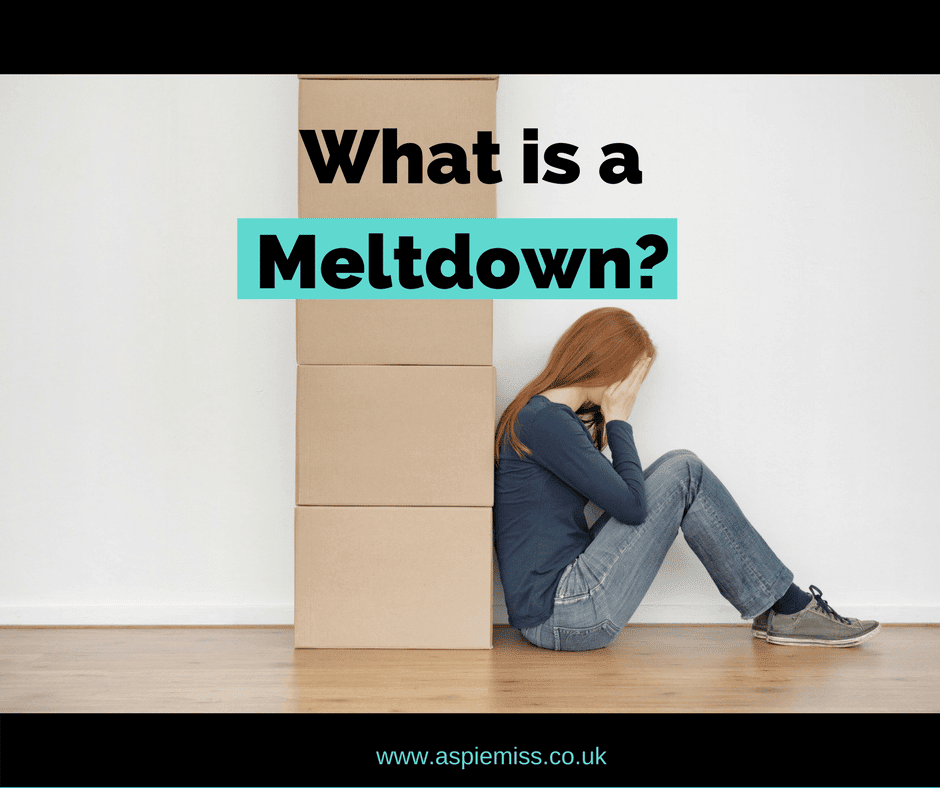Can You Stop A Meltdown
While the symptoms of an autism meltdown can be soothed or lessened with medication, once it has begun, it cant really be stopped.
The best thing to do during a meltdown is to attempt to separate yourself or your loved one from the trigger or environment as quickly as possible whether you physically leave an event or escape to a quieter space.
- Dim any lights.
Supporting An Autistic Person During A Meltdown
Its understandable that youd want to support someone when theyre visibly upset.
While an autism meltdown cant really be controlled, there are strategies that may help diffuse the emotional response.
You can only try to manage and regulate it in the moment and support us during the recovery afterward, says Jane. Its an emotional response that you have to ride out.
When it comes to supporting autistic individuals, Jane says that its important to remember that theres no one singular trigger for a meltdown.
Its not usually one event, even though it might seem like theres a triggering event from the outside, they explain.
Meltdowns are always a combination of factors and often happen when we become dysregulated or overstimulated by stress, sensory input, sudden changes to our emotions, and more because our body and brain are communicating to us that we have reached a limit.
During a meltdown, focusing on sensory and emotional support should be prioritized. Rather than using reason, try the following instead:
- Keep your anger or frustration in check.
- Reduce verbal communication by using visual representations and yes or no questions.
Meltdowns can be draining to those who experience them, so Jane suggests maintaining your patience even after its over.
Allow autistic people time to recover by considering their sensitivity to sensory input. Give them some space and quiet to work through the meltdown at their own pace.
How To Deal With A Meltdown
As no two kids with ASD are the same, there is no one-size-fits-all strategy on how to handle meltdowns. Not all meltdown strategies are guaranteed to work on every child on the spectrum. However, there are some general techniques that can be customized to your childs behavior and personality.
The best way to prevent your child from having a meltdown is to predict and avoid triggers. This can be avoiding crowds, establishing a set routine, and planning ahead.
However, when a meltdown is already happening, you can try the following approach:
- Leave the room or location to help your child calm down
- Use calming devices like a fidget toy, noise-canceling headphones, or a weighted vest
- Choose a good time when your child is receptive to learning and teach breathing exercises, meditation, and counting from one to ten
- Prevent injuries to your child or others during a meltdown by being in a safe place
- Keep yourself calm as your child can feel your frustration and worsen the meltdown
- Keep your face and voice neutral and be at arms length in case the child reaches out
- Children who are in a meltdown cant be reasoned with so dont rely on logic
Read Also: How To Teach Yes No Questions Autism
How To Support Your Child
Taking steps to support your child may reduce or prevent meltdowns. It can help to:
- Have a visual system to show them whats coming up that day. Timetables or visual timers can be useful.
- Use emotion thermometers or labelling to help communicate.
- Be consistent. Put routines in place. Make sure your child knows when things are happening. Try to keep the routines every day.
- Think about how you will support your child if unexpected events happen.
- Help you child understand what to expect in certain situations. Social Stories can support with this.
How To Help Prevent Meltdowns And Shutdowns

Preemptive planning can really help to mitigate against triggers that might lead to a meltdown.
For example, you can reduce anxiety related to uncertainty about certain situations by providing information about what to expect in advance – such as a visual timetable or agenda.
Another way to reduce the likelihood of a meltdown is to create environments that don’t overwhelm the senses. For example, allowing children and young people to wear ear defenders in noisy rooms or dimming the lights to create a less harsh ambience.
It can be very difficult and distressing to support someone during a meltdown, so knowing what to do in advance is key.
The best way to find out what causes someone to have a meltdown is to ask them or someone who knows them well.
The best remedy for a shutdown is giving the person the space to rest, recuperate and recover without placing additional demands on them. A shutdown can be like a reset for an autistic person.
Read Also: Can You Tell If Your Baby Is Autistic
Is Level 2 Autism High Functioning
Yes, level 2 autism is high-functioning. This kind of autism is also called Aspergers syndrome by doctors.
People who have this kind of autism would need more support such as psychological therapies like speech therapy or social skills training.If you want to learn about this condition and how to implement effective strategies to improve their quality of life, check the Best Books for High Functioning Autism.
You May Like: Low Level Autism
Coping Strategies For Dealing With Meltdowns
Meltdowns are something which many people with autism experience and which they may have experienced since childhood. Meltdowns can be distinguished from tantrums on the basis of having no end-goal in sight. You dont have a meltdown because you want to achieve something from it . You have a meltdown because you have absolutely no other way of responding to a situation. In terms of emotional regulation, youve completely lost your ability to maintain control.
Meltdowns may result in you screaming, crying, throwing things, shaking, and/or yelling hurtful comments. They can be scary and damaging to people around you and, when youve had a meltdown, chances are you feel pretty bad about it.
So how can you deal with the fallout? The following strategies may help.
1. Accept that you did not want to act in this way.
2. Have a safe place for the immediate aftermath.
3. Working with those people close to you.
Meltdowns have an impact on people close to you and witnessing someone who is having a meltdown can be a disturbing experience. When you are ready to, it is important to discuss your meltdown with those people who may have been affected by it. It could also be useful to show them some autistic resources which explain the experiences of other people with autism who experience meltdowns, as it can be a very difficult concept for other people to understand.
4. Recognise when a meltdown is coming.
Read Also: Does Jerry Seinfeld Have Autism
Don’t Miss: Does Adhd Cause Tics
Acknowledge Your Childs Emotions
Instead of telling your child to stop crying, you can let him/her know that you understand his/her feelings. You can validate feelings without giving in. For example, saying something like, I know youre upset that you cant have that toy, but we cant buy it right now. Maybe next time. This lets your child know that you feel bad that he/she feels bad, but there is nothing you can dofor now.
What You Can Do In A Meltdown
Remember this key element, you cannot avoid meltdowns entirely. As a parent, your first goal is to remain calm.
Safety is a must. Have a strategy in place to protect your child and yourself from harm.
Move to a quiet place, away from the stimulation that may have evoked the overload until the meltdown is over. When you are in a public area, this requires pre-planning, such as knowing where a quiet place is that you can take your child to. Also, pack a survival kit of familiar and soothing items that are your childs favorite coping mechanisms.
Related: What Nobody Ever Tells Us About Meltdowns
You may not be able to stop or slow down a full-blown meltdown with distractions or a quiet space. A meltdown may simply be an eruption that must fizzle out on its own. Your job is to remain calm and keep both you and your loved one safe.
Prevention is your best defensive tool. Keep practicing and do not expect perfection. Your child will learn from you, learn how to communicate his or her basic needs and anxieties, non-verbal or not. Even though meltdowns may still occur, know that they may reduce over time.
You May Like: Can Someone With High Functioning Autism Join The Military
Meltdowns And Sensory Processing
If your or your child’s meltdowns are often brought on in areas with lots of movement, sound, light, smell or touch, then it could be brought on by sensory overload. Occupational therapy can help increase tolerance of strong sensory input. People on the Spectrum often struggle with places such as airports, grocery stores, cafeterias, crowded areas like railway stations, busy kitchens, school assemblies, and so on.
Lots Of Autistic Children Will Experience Meltdowns And Watching Them Go Through It Can Be Really Distressing For Parents Especially If You Dont Know How To Help Them Here We Talk To Libby An Autistic Adult Who Experienced Daily Meltdowns When She Was A Child If You Want To Know What A Meltdown Really Feels Like For A Child Read On
Meltdowns are a common behavioural trait for autistic people but little is known about what actually happens during a meltdown and how that person feels when experiencing this sort of behaviour. I hope to explain meltdown behaviour as best as I can based on my own personal experiences as a child.
Meltdown behaviour is expressed by an individual when they are unable to cope within their environment and have become overwhelmed, usually there will be something to trigger this behaviour. Commonly, my triggers are bright lights, crowded areas and loud noises. The more unusual triggers of mine include objects which are out of place or when there are odd numbers of objects instead of even numbers. Everyone will have different triggers and unfortunately those triggers can be difficult to identify.
Me
Let me introduce myself, my name is Libby and I am an autistic adult. I was diagnosed with autism as a toddler, shortly after I was diagnosed with selective mutism disorder. I am twenty-three years old, I study animal science at university and I actively share my experiences online. I have a Twitter page called GrowingUpAutistic which has allowed me to share my story with others and provide support to others.
My meltdowns
What do meltdowns feel like?
Depersonalisation disorder
Raising awareness
Don’t Miss: How To Get Custody Of A Autistic Child
What Triggers Autistic Meltdowns
An autistic meltdown is usually caused by a sense of overload. Your child will have no control over their reaction. They may not be able to tell you when they feel overwhelmed.
Learning what triggers a meltdown can help you feel more prepared. Every child is different, but some common triggers include:
- Sensory overload or understimulation. This is when a child is sensitive to sound, touch, taste, smell, visuals or movements.
- Changes in routine or dealing with an unexpected change. People with autism often prefer to have a routine in place. They can be sensitive to even small changes.
- Anxiety or anxious feelings.
- Being unable to describe what they need or want. Communication is often non-typical for those with autism. It can feel frustrating for them when theyre misunderstood.
Keeping a behaviour diary can help spot possible patterns. Note down when meltdowns happen. Write down what you were doing, where, and your childs reaction.
How Do You Calm Down An Autistic Meltdown

Read Also: Is Autism And Autistic Disorder The Same Thing
What Meltdowns Feel Like To Me As An Autistic Adult Medium
- Highest rating: 5
- Summary: What followed was an immediate reaction of furious fists pounding the steering wheel, shaking uncontrollably, screaming at the top of my lungs, and fits of
See Details
- Highest rating: 4
- Summary: The autistic person feels like they can no longer control anything, and may burst into tears, scream, or self-harm. Meltdowns are
See Details
A Note On Neurodivergent People
Theres no cure for autism, and many people in the autistic community dont feel the need for one. Instead, they recognize autism as a neurotype rather than a disability or condition that needs to be cured.
Neurodivergent folks, including autistic people, may communicate in different ways. For instance, avoiding eye contact and fidgeting may help them concentrate better or feel more comfortable in conversation it doesnt always mean disinterest.
Neurodivergent individuals may also respond to sensory stimuli differently than neurotypical people. These responses may include autism meltdowns, which are usually out of the autistic persons control.
Also Check: What Are The Characteristics Of A Child With Autism
Seven Differences Between Tantrums Vs Autism Meltdowns
To most people looking from the outside, the differences between tantrums vs meltdowns can appear almost indistinguishable if you don’t know what to look for – after all, both autistic meltdowns and temper tantrums can incorporate screaming, crying and kicking. However, autistic meltdowns do not always look like this, and their root cause is fundamentally different from a tantrum. To help those who suffer from sensory meltdowns, it’s essential to be able to differentiate tantrums vs meltdowns.
In this post, we’re going to discuss seven differences between autism meltdowns vs tantrums, some signs that a meltdown is occurring or impending, and some strategies to help someone who is having a meltdown.
During A Meltdown: What To Do
Sometimes you cant avoid a meltdown. When a meltdown happens, these steps can help:
Don’t Miss: Is My Child Autistic Or Gifted
How To Handle A Meltdown In Public
This can happen to anyone. Parents and caregivers could be low on patience while also hurting for their struggling child.
Remember that autistic children do not have meltdowns and cry or flail just to get at you.They cry because they need to release tension from their bodies in some way. They are overwhelmed with emotions or sensory stimulations.
There are some ways to effectively support your child when they are having a meltdown in public. Here are some of them.
Equip them with coping skills: Meltdowns cant be helped at that very moment. But afterwards, you can teach your child how to regulate their emotions. Try relaxing activities like going for walks. These calming activities will help them calm down even before the meltdown happens.
Feeling safe and loved: Trying to talk a child down from having a meltdown is not a great strategy when it comes to calm an autistic child. Be there for them. Let them know that they are safe at that moment. Stay close as much as their comfort allows. Dont leave them alone to be out of a meltdown and find no one in the room. This could send a message that they dont deserve to be around the people they love when it gets tough.
Empathy is key: Listen and understand their situation. Tell them expressing emotions is okay, and sometimes it can get overwhelming. If your child with autism can feel like they are being heard, they will feel that their experience is validated. Try to give them tools to express themselves in a safe way.
What Are The Different Types Of Autistic Shutdown
Autistic people may appear cool as a cucumber when in shutdown mode . However, not all is how it seems as, unlike an autistic meltdown which sees the mind reboot our bodies, a shutdown will see our minds rewire our senses, to protect us from what is causing the distress.
According to Autism: An Inside-Out Approach, this can result in one of two autism shutdown subdivides:
Both of which may seem preferable to the destruction that is a meltdown, but dont let this deceive you into thinking that they dont have strengths and weaknesses of their own. For example:
Recommended Reading: What Is The Autism Symbol
Don’t Miss: Is Walking On Toes A Sign Of Autism
What Is A Meltdown
A meltdown is an intense response to an overwhelming situation. It happens when someone becomes completely overwhelmed by their current situation and temporarily loses control of their behaviour.This loss of control can be expressed verbally ,physically or in both ways.
A meltdown is not the same as a temper tantrum. It is notbad or naughty behaviour. When a person is completely overwhelmed, and their condition means it is difficult to express that in another way, it is understandable that the result is a meltdown.
Meltdowns are not the only way an autistic person may express feeling overwhelmed.They may also refuse to interact, withdrawing from situations they find challenging or avoiding them altogether.
Autism Meltdown Coping Strategies

If your child, or someone else you know, is suffering from a sensory meltdown, you should be aware of the different techniques and tools that can reduce sensory overload and help contain the situation. Remember that people react differently to different support methods, so try to establish what works best for the individual.
- Stay calm and ask them if they are okay or need anything. Reassure them that everything will be okay.
- Identify what might have triggered the meltdown and, where possible, either remove the person from the trigger or the trigger from the person. Note their pattern of behaviour to avoid or anticipate potentially triggering environments.
- If they aren’t triggered by physical contact, offer to place a hand on their shoulder or hug them deep pressure therapy can help with meltdowns, but only from the right source.
You May Like: What Is The Difference Between Autism And Sensory Processing Disorder